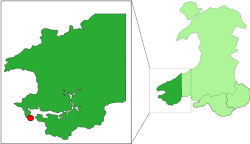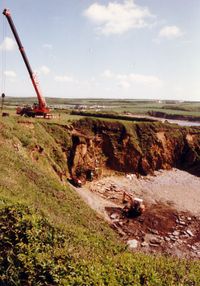Sea Empress
2008/9 Schools Wikipedia Selection. Related subjects: Air & Sea transport
The Sea Empress was the name of a single hull oil tanker that became infamous in February 1996 for the devastation it caused to the coastline of south-west Wales when the ship ran aground.
Statistics
- Vessel name: Sea Empress
- Home port: Monrovia, Liberia
- Owners: Alegrete Shipping Co, Inc., Monrovia
- Construction: 1993 (delivered)
- Country of construction: Spain
- Length overall: 274.3 meters (899.93 ft)
- Beam: 43.2 meters (141.73 ft)
- Draft: 17.02 meters (55.84 ft) loaded
- Displacement: 147,273 tonnes deadweight (162,340 tons US)
- Capacity: 164,156 cubic meters (1,032,510 barrels)
- Propulsion: direct-drive diesel, single propeller
- Engine rating: 13,475 kW (18,061.96 horsepower)
- Classification society: Det Norske Veritas
Grounding
On the evening of 15 February 1996 the Sea Empress was entering the mouth of the Cleddau Estuary on her way into Milford Haven in Pembrokeshire to deposit its oil cargo at the refinery. Sailing against the outgoing tide, at 20:07 UTC the ship was pushed off its course by the current, and hit rocks in the middle of the channel, which punctured her starboard hull causing oil to pour out into the bay.
Short-term effects
Over the first few days of the disaster an estimated 73,000 tonnes out of the ship's 130,000 tonne cargo of North Sea crude oil spilt onto the surrounding coast, causing a great deal of environmental and aesthetic damage to the coastline and its marine life and wildlife in an area which lies within the protection of the Pembrokeshire Coast National Park.
Birds
The most visible effect of the spill was seen in the large number of oil covered birds that were shown on television and in newspapers. Amongst the birds affected were guillemots, razorbills and the worst affected bird, the Common Scoter duck. 83% of the birds affected were Common Scoter, and it is estimated that 5000 of the 15000 population in the area were killed. The RSPCA set up a temporary bird hospital in Milford Haven to try and treat as many birds as possible. Members of the public also helped rescue birds. It was later revealed in a study by the British Trust for Ornithology that the average survival time for a rescued oiled bird was seven days.
Seals
Although the Sea Empress ran aground near to a breeding area for the grey seal, the time of year meant that only a minority of seals were in the area. Although some seals showed signs of oil on their coats, there is no record of a seal dying as a result of the spill.
Beaches
Beaches were covered in crude oil.
Long-term effects
The total cost of the cleanup operation was approximately £60 million
It took almost five years for the coastline to be fully cleaned up and restored by the Pembrokeshire Council and wildlife conservationalists.
The oil tanker was recovered and was subsequently renamed continuing to operate until 2004. There was much speculation in the media at the time over the fate and unreliability of old single hull tankers which had been the cause of another disaster in Scotland just a year earlier

